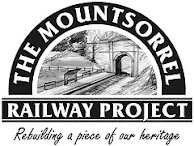A major part of this work involved the installation of check rails to the two tight curves either side of the bridge at Swithland Lane. Check rails are a third rail that fits on the inside of the curve and helps to relieve forces that would otherwise act on the outside rail causing it to wear. In all some 350 special double chairs had to be sourced to hold the extra rail. As we are using historically correct bullhead rail opposed to modern flat bottom rail, plus the chairs had to hold the rails with a 2 inch spacing instead of the more common 1 3/4 inch spacing, it was extremely difficult to find the chairs of the correct type we needed.
Project funds didn't stretch to commissioning new chairs to be cast especially. This would have cost many tens of thousands of pounds. Instead we set about trying to buy second hand chairs from other heritage railways. Volunteers quite literally travelled to various locations over the full length of the UK to collect what at times were only half a dozen chairs. Gradually we nibbled away out our outstanding total, fitting chairs to the track as we went.
Eventually both curves had all their double chairs fitted and we were ready to fit the rails. This wasn't as straight forward as fitting normal track. The check rails are on a curve so we had to bend the rails by hand as we lifted them into the chairs.
At the end of each check rail section the rails bend inwards to act as a guide to lead the trains wheels into the gap between the check rail and the running rail. We set about bending the rails by hand using a device called a "Jim Crow". This clamps across the rail to bend and a threaded bar is gradually wound against the opposite side of the rail forcing a bend point to occur. It took six strong adults on a long bar to wind the machine and force the rail. There was certainly a lot of sweat that went into that one!
The final task was grinding any lips on the inside edge of the check rail to ensure that the train wheels met no obstructions as they pressed against the check rail.
With the check rails complete our next task was to lay the remaining top ballast all the way to the end of the line. We are grateful to Lafarge Tarmac Mountsorrel Quarry for again supplying the 300 tonnes of ballast needed for the last stretch of the line. We would also like to say a big thank you to the GCR and in particular Nick Tinsley and his p-way team for running the ballast train to drop the remaining ballast.
Whilst the track work has been progressing over the past couple of years the cutting sides have been becoming very overgrown again with brambles even growing across the track in places! Both the track gang and the ecology group are working together to strim and cut back the line side vegetation. We started at Bond Lane and are working our way towards Swithland junction. So far we have reached the bridge at Swithland Lane so still have a mile to go.
 |
| It is hoped to build Mountsorrel Halt on the left of this view at Bond Lane. Track will be laid here after the platform is built. |
The next task for the track is a visit from a machine called a tamper. The tamper proceeds along the track fine tuning the alignment and packing the ballast underneath the sleepers to ensure the track is fully supported. The tamper visit has been scheduled for November. This will leave the track itself at a standard where passenger trains can run, but we still have more to do before the rest of the line is up to the same standard. Signage needs to be sourced and fitted, which include things like speed limit signs and whistle boards, at the end of the line we have a buffer stop and sand drag to build, plus we still have a mile of railway formation sides that need their vegetation trimming back.
We have volunteer sessions on Tuesday, Thursday and Saturday each week and we need your help to finish the line so the trains can start running as soon as possible. It's not too late to get involved, if you are interested in volunteering with the project please contact project leader Steve Cramp by email.










No comments:
Post a Comment